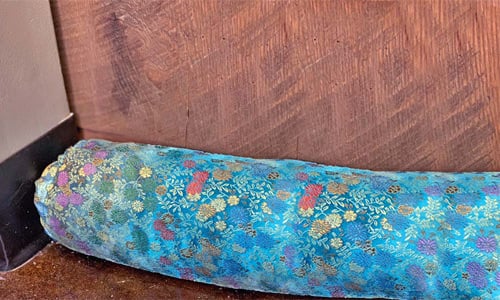Have you noticed your heating bill creeping up? What about cool air lingering around doors or windows? Or drafty doors sapping the warm air out of your home? While not a sufficient substitute for fully weatherproofing your home, draft stoppers can offer immediate relief from cold drafts and unusually high energy bills in a pinch.
How do draft stoppers work?
Also known as “draft blockers” and even “draft dodgers,” draft stoppers sit at the interior base of drafty doors and windows to create a barrier between the inside of your home and chilly drafts. While installing a new door bottom and replacing your weathersealing will ultimately be more effective and efficient long-term solutions, draft stoppers are great to have on hand in case your home needs immediate, short-term protection from the great outdoors.
DIY Draft Stopper
Draft stoppers can be purchased from most home improvement stores, or you can opt for the DIY solution. You’ll simply need to make the fabric tube, which can be made out of any material you prefer. Cotton or polyester fabric swatches or old pillowcases are affordable, easy-to-use options.
Since draft stoppers work by creating a physical barrier around the gaps at the bottom of your doors and windows, whatever material you choose to fill the fabric tube with should be malleable, small enough to wedge into place, and heavy enough to stay put.

Rice, sand, and popcorn kernels are popular materials for filling draft stoppers as they are less easily penetrated by cold winds than more breathable, lightweight fillers. Though more cumbersome to move around than their cotton or polyester counterparts, draft stoppers with heavier filling are often worth the hassle of moving them around since they create a more effective seal against doors and windows, and keeping heated air safely indoors and cold drafts outdoors where they belong. Heavier materials can help you save energy and money on your utility bills until you get a chance to get around to properly weatherizing your exterior doors.
One perk of making your own window and door draft stoppers is that you can customize their size for each window or door in your home. While they can help you save on energy costs and work well for interior doors if you’re trying to conserve energy by only heating or cooling specific rooms in your home, draft stoppers are no substitute for properly weatherstripping your exterior doors and windows.
Weathersealing prevents cold air from penetrating your home, boosts your energy efficiency, and helps save money on utility bills. For more on how to weatherstrip and weatherseal your home, see: What You Need to Know About Weathersealing
